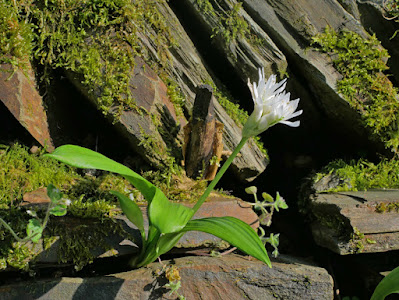It was still quite cold, though we had a period of dry weather with associated high pressure. This was a welcome relief from the endless rain of previous weeks, but brought with it cold Easterly and Northerly winds. Thus, Spring was still delayed.
I recorded a monad around Little Petherick, a small village between Wadebridge and Padstow and found my first ever Tall Ramping Fumitory. I found it again since, in my back garden, which is a new build with bare dirt and no plantings. Fumitories tend to all look similar, so lots of photos and measurements are normally needed to identify it. In this case though, this is the only species with larger flowers (over 11mm) with its top petal being all the same colour. For brevity, I only include this one photo, but in the field, I take many of all parts of the flowers and leaves.
Fumaria bastardii var. bastardii
Some of the views were pretty good too, though for most of the walk, you couldn't get near the creek's edge due to trees or fences. I was surprised here to find masses of Wild Madder (Rubia peregrina) which is very rare in Kent, but seems ever so common here. I should catch it in flower in a couple of months time.
The only sure 100% way to tell Polypodiums apart, is to microscopically examine the spore carrying aparatus in the sporangia.
this wasn't possible for me until Lidl happened to sell a cheap microscope which I bought and used straight away on these Polypodies. I could even attach my phone and take a photo, excellent!
I was pleased to say that the morphology of each plant matched the determination given by the microscope. This is Polypodium interjectum or Intermediate Polypody. The photo doesn't show all the rings that you need to count to determine the species, but it was my first attempt at one!
There are drawings for each species of Polypody in Stace 4, page 41, have a look.
No doubt I will be using the microscope on pollen and seeds from assorted other species too.
The first Wild Garlic were flowering, or Ramsons as some know them as. They smell strongly of garlic so can't easily be mistaken for anything else. I included this photo as it shows the flowers and the leaves which are bright green, shiny and glossy. They usually grow in shaded places by roadsides, but they are happy with anywhere permanently damp. On the ground they usually grow in dense mats of hundreds of plants.
Allium ursinum
The first Wood Anemones were out too now, these in a lay-by off the A39 north east of Wadebridge. There are no huge carpets of them like in the East of England, but they look great nonetheless. Again, I include a photo to show the leaves too. These sometimes persist into late Summer allowing one to record them after the flowers have long gone.
Cornwall has miles of slate or stone walls covered in earth, often hundreds of years old. As such, you can get underneath many plants that grow on them for photographs, without getting muddy knees, like this one!
Anemone nemorosa
In a boggy area off the road were these mysterious leaves. After some research I determined they belonged to the Greater Cuckooflower, a plant I have never heard of until now. I will return to see some flowers I hope later on in Spring.
Cardamine raphanifolia
More fantastic scenery, this time across the River Allen, the whole length of which is an SSSI for plants and insects. This is actually a footbridge and a ford across the river. It drains into the River Camel at Sladesbridge just upstream of Wadebridge.
By the ford, I found a plant I recognised as Water Purslane. Unfortunately, it was in flower bud with none yet open, however, the flowers are small and unexciting anyway... This plant sometimes grows in mud or places that flood in Winter and dry out in Spring.
Lythrum portula
By the river, I also found a mystery plant that I had not seen before. One patch by the road and another half a kilometre upstream well away from any habitation and clearly not planted. My Twitter botanist friends identified it for me as Lesser Knotweed. It was first found in the area over 10 years before 2 km upstream. So it has obviously spread downstream from there over the past decade or so all by itself. At present though, I wouldn't say it was smothering out other plants. Two patches in a large distance isn't really of concern.
Koenigia campanulata
Above: habitat
Below: close up showing the purple veining and edging to the leaves.
My final plant stood out as very obvious as it was bright blue. It was a Primrose, much like the type you buy in a supermarket at 50p each. I took some photos as it was obviously not planted and was amongst native plants on old fly tipped soil. I laterdiscovered the find was a first for VC1 and 2 (West and East Cornwall) for this particular cultivated hybrid. I can't say such garden escapes particularly excite me, but it's still nice to get a 1st occasionally.
Primula x pruhoniciana
So ended March. April began, still with a cold weather pattern overall, but as I write this on the 5th April, it is currently mild, so Spring will come in full soon. It's also Dandelion time, so some of those will no doubt feature in my next blog. As I now live in Cornwall and not Kent, I am sure I will encounter completely different Dandelion species too.
Take care
Dave
Twitter: @botany2021















No comments:
Post a Comment
All comments are moderated before publication, so please don't bother spamming me, thank you. Genuine comments most welcome.